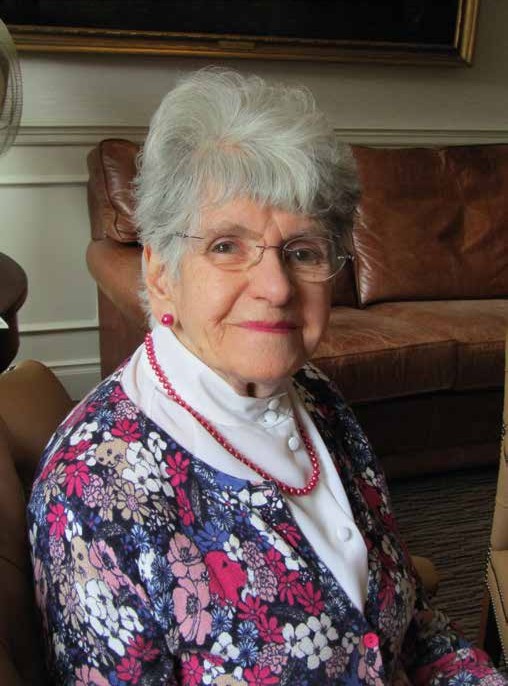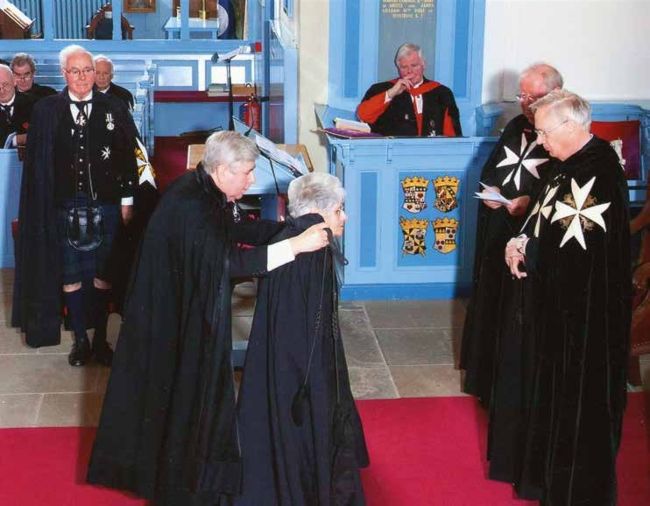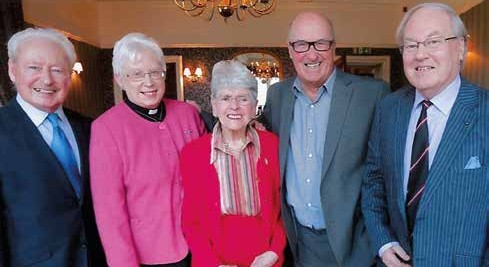From abandoned baby to Damehood
Jackie Macadam learns about the life of author and charity worker Katharine Liston.
A pitiful wail pierces the dreich early morning of a Glasgow street. A baby’s hand clutches the wool blanket that keeps the worst of the November cold from the tiny body.
It was an inauspicious start for a young life, but one that certainly hasn’t held the very extraordinary Katharine Liston back.
We’re having lunch in her club overlooking the gallery of modern art in Glasgow city centre.
Katharine is a member of Helensburgh Church. She’s been an elder for 40 years.
She worships there every Sunday and is as involved as she can be. Even though she’s in her eighties, she’s still very active, particularly in her charity work, for the Ross Priory and the John Liston Scottish Charitable Trust which was set up to work towards preventing poverty, advancing education, advancing religion and encouraging health. The Trust makes regular grants, donations and gifts to organisations that work in these fields, particularly in work with children and young people, animal welfare, people with disabilities or health problems and older people.
It’s a far cry from that abandoned newborn on the steps of Rottenrow Maternity Hospital in 1930 and a voyage of many years, all filled with irrepressible humour and energy.
“In those days, abandoning babies like that happened. It was rare, but it happened,” says Katharine.
“I was adopted by a family that knew the doctor, or something,” she says. “It would never be allowed to happen like that these days. There was, as far as I can tell, no vetting, and to be honest, the couple who adopted me, and later my sister, were entirely unsuited to bringing up children.
“My sister was, like me, an orphan, and my ‘mother’ was careful never to let us bond. She was not a loving person and played us off against each other.
“My father was kinder, but he had significant issues. My parents didn’t sleep together. I slept in bed with my mother, not in a room with my sister. We were simply never allowed to really get to know each other.
“We were brought up to feel that we were a disgrace – illegitimate, unwanted. It was mental abuse of the worst kind.
“As we grew we were little more than servants. The awful disgrace of being illegitimate and the fact that I should always be incredibly grateful for having been adopted meant that I was called on to ‘pay her back’ in some way.
“The really awful thing was that my sister, Jane, and I were not even told our actual birthdays. I was told mine was the same day as my mother’s and Jane’s was changed as well. I was never allowed to see my birth certificate. I felt like a complete fool as an adult, when I discovered that I’d given my employers the wrong date of birth for myself. It was ridiculous.
“There was a nurse who stayed with us and who was not just a good cook but gave us some of the love we craved, and an elderly lady friend of my mother’s, called Auntie Mabel, who was also fond of us.
“But we weren’t allowed to establish friends or relationships with other people. Our attention had to be focused solely on mother.
“As I say, they were entirely unsuited to be adoptive parents.
“It was an unhappy childhood but I guess it gave me the ability to take strength from myself later on.
“Luckily for me though, my mother’s father was fairly well-to-do and he wanted to make sure that us girls got at the very least, a good education.
“I was sent to a small private school where I did well. I was a good student and enjoyed learning. I especially liked classical languages. I went on to do an Arts degree at Glasgow University where I studied Latin and Greek in particular.
“My sister and I were involved in the Church from an early age, and religion was, to some degree, an escape for both of us. She took a different path from me though, and became a nun in the Roman Catholic Church. She’s in a closed order and I go to visit her once a year. It is a great hurt to me that we were so comprehensively kept apart and played against each other as children.
“Unfortunately, my upbringing had left me as a very nervous person. I felt ill all the time, very nervy and emotional. “I was involved in the Church of Scotland and decided to visit the minister and ask his advice. He said I should see a psychiatrist and I agreed.
“The psychiatrist told me that I’d not be likely to make a successful marriage and he said it was essential for me to leave home.

Katharine Liston
“I discovered, when I talked to people I knew, that my mother had been so angry at my leaving home, that she had called round all my friends telling them not to have anything to do with me.
“By now, in my early 20s, I took the bull by the horns and started looking for some digs.
“I found a room and a kitchen in Muirend, not too far from my home. The landlady was a kind person and took me in.
“I was terribly unprepared. I had to borrow a cup, plate and saucer from her as well as a knife, fork and spoon. I had no money to buy even the basics. It was very difficult for me living in digs alone at 24.
“I discovered, when I talked to people I knew, that my mother had been so angry at my leaving home, that she had called round all my friends telling them not to have anything to do with me.
“My one passion at the time was playing the oboe.
“Living in digs made it difficult for me to practise as I felt I had to wait until everyone else was out of the house before I could play it.
“I had a job at Glasgow University Press, proof-reading Latin and Greek for their publications.
“From there I moved to Blackie’s and from there to Collins, where I stayed for 10 years.
During that time, when I was very much finding my feet in lots of ways, and my church family was still a big part of my life, but I still hadn’t found love.
“Of course I’d been told that I’d likely never marry.
“I didn’t agree with that, so I joined a marriage bureau! It was a select one in Barnton in Edinburgh and quite early in the days of such things, but after a while I wasn’t happy with the men they were sending me. They were too far away, for a start. Then I was put in touch with a chap who lived a few miles down the road.
“We met at an ironmongers then had dinner at a hotel in East Kilbride.
“He felt he didn’t have much in common with me – well, who would? – and he thought we should call it a day, but I disagreed.
In 2015 I received a letter promoting me from Commander to Dame of the Order of St John. It is an honour I still hold dear to this day. No one could have imagined that that small baby on the steps of Rottenrow could have ended up like me.

Katherine receiving her Dame of the Order of St John
“I thought he could be The One.

Katharine at the launch party for her book
“His name was Iain and after getting to know each other we found that actually we got on together very well. He was very reserved while I was much chirpier. He was Director of a plumbers’ merchants in Glasgow and had a great love of yachts. We were married in Netherlee Church in 1969 by the minister, the Rev Stanley Mair. I enjoy church and Iain had joined earlier. I didn’t want to be a white bride so I chose a lovely silver grey dress and coat with a turquoise zig zag pattern. My sister, Jane, managed to come back from India just in time. She was terribly thin but we got her fixed up with a dress.
“Shortly after the wedding, Jane was accepted into a convent in Wales. Some time in 1970 we got a phone call from a friend to say that she had called on my mother and found her dead in her chair.
“Shortly after this, I moved from Collins, where I was an editor, to the University of Strathclyde. I had sent in a general enquiry letter to them, little realising they’d been struggling to find an editorial assistant. I was described as an ‘answer to their prayers’.
“We lived in Iain’s flat for a while but soon began to feel the need to get a house of our own.
“We bought a house and it was suggested to me that I should learn to drive. I LOATHED driving but I wanted to master it so I persevered. One afternoon I thought I’d like to to master a particularly tricky car park above some shops in Clarkston but I changed my mind and parked along the street instead.
“As I crossed towards the shops there was a massive ‘bang’. Ambulances flooded the area. It was the Clarkston Disaster of October 21 1971. If I’d carried out my initial plan, I’d have been right above when the gas pipe blew up.
“We liked our house very much.
“Iain and I had lots of friends and were involved in quite a wide social circle. Iain’s mother had begun to get a little muddled and we made arrangements for someone to come in and help her, but every Sunday, we went there, took her to Pollokshields Church and spent the day with her. Between events connected with the university, and Iain’s business, we had plenty to do. Iain had been a member of the Royal Scottish Automobile Club until it closed many years later.
“He was also a member of the Order of St John Association – the fund raising arm, if you like in these days, for the Order, and I have remained a huge supporter ever since.
“I was admitted in 1984, became an Officer in 1990 and Commander in 2008.
“Ross Priory, on Loch Lomond, was acquired by the University in 1971 and I immediately became a member and Iain an associate. I served on the Ross Priory Committee of Management and served for 24 years.
“Early on, I felt there was a need to raise money for the Priory and so began a long and lovely association with it. It started with an initial ‘A Twiddle on the Fiddle’ where a local very respected professional violinist entertained around 50 guests for a hugely successful evening and I followed it up with many more.
“It was during this time I met and became good friends with the actor John Cairney. He became fascinated by my personal story and more or less insisted that I write a book about it. I was less than enthusiastic but I did it.
“After Iain’s mother died, we did a fair bit of travelling together and went all over the world together. Iain set up a charitable trust – the John Liston Scottish Charitable Trust in the mid 1990s and after his diagnosis of progressive supranuclear palsy, a rare and dreadful illness – and I took the Trust over when he died in 2007.
“I still feel it’s Iain’s money and I try to keep in mind charities he’d have been keen to support. His death was a great heartbreak to me and I miss him even now.
“In 2015 I received a letter promoting me from Commander to Dame of the Order of St John. It is an honour I still hold dear to this day.
“No one could have imagined that that small baby on the steps of Rottenrow could have ended up like me.”
Katharine’s book, ‘Doorstep to Damehood’ is available from www.neetahbooks.com